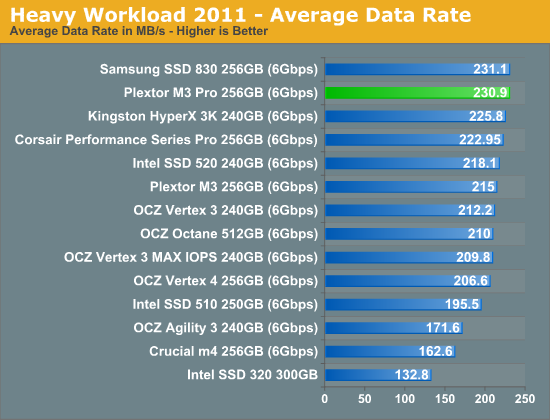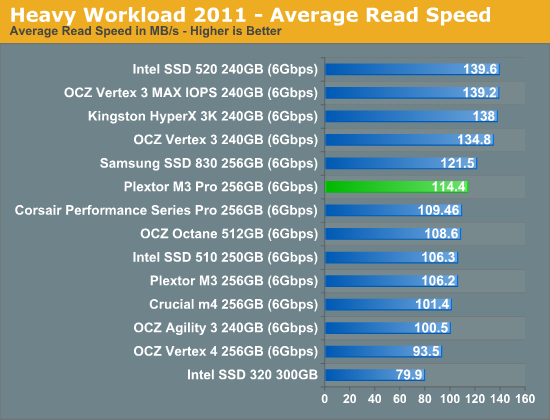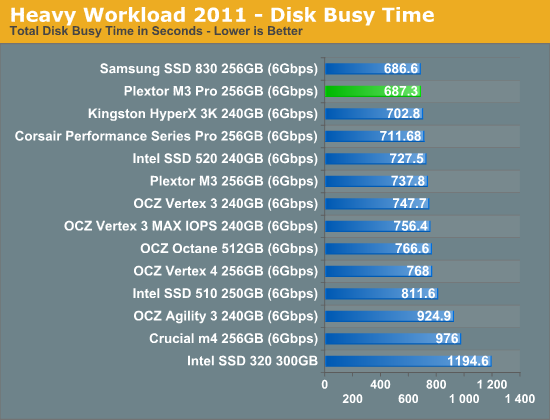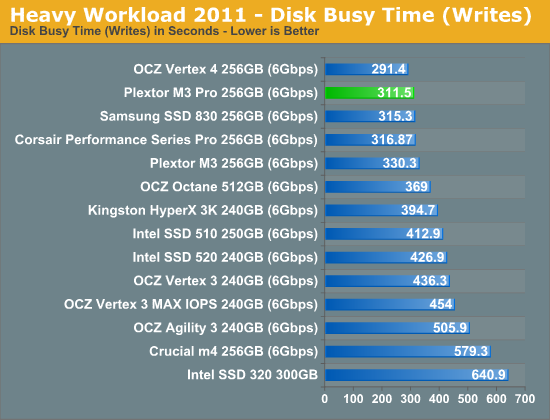Plextor M3 Pro (256GB) Review
by Kristian Vättö on July 1, 2012 1:45 PM ESTAnandTech Storage Bench 2011
Last year we introduced our AnandTech Storage Bench, a suite of benchmarks that took traces of real OS/application usage and played them back in a repeatable manner. Anand assembled the traces out of frustration with the majority of what we have today in terms of SSD benchmarks.
Although the AnandTech Storage Bench tests did a good job of characterizing SSD performance, they weren't stressful enough. All of the tests performed less than 10GB of reads/writes and typically involved only 4GB of writes specifically. That's not even enough exceed the spare area on most SSDs. Most canned SSD benchmarks don't even come close to writing a single gigabyte of data, but that doesn't mean that simply writing 4GB is acceptable.
Originally we kept the benchmarks short enough that they wouldn't be a burden to run (~30 minutes) but long enough that they were representative of what a power user might do with their system. Later, however, we created what we refer to as the Mother of All SSD Benchmarks (MOASB). Rather than only writing 4GB of data to the drive, this benchmark writes 106.32GB. This represents the load you'd put on a drive after nearly two weeks of constant usage. And it takes a long time to run.
1) The MOASB, officially called AnandTech Storage Bench 2011—Heavy Workload, mainly focuses on the times when your I/O activity is the highest. There is a lot of downloading and application installing that happens during the course of this test. Our thinking was that it's during application installs, file copies, downloading, and multitasking with all of this that you can really notice performance differences between drives.
2) We tried to cover as many bases as possible with the software incorporated into this test. There's a lot of photo editing in Photoshop, HTML editing in Dreamweaver, web browsing, game playing/level loading (Starcraft II and WoW are both a part of the test), as well as general use stuff (application installing, virus scanning). We included a large amount of email downloading, document creation, and editing as well. To top it all off we even use Visual Studio 2008 to build Chromium during the test.
The test has 2,168,893 read operations and 1,783,447 write operations. The IO breakdown is as follows:
| AnandTech Storage Bench 2011—Heavy Workload IO Breakdown | ||||
| IO Size | % of Total | |||
| 4KB | 28% | |||
| 16KB | 10% | |||
| 32KB | 10% | |||
| 64KB | 4% | |||
Only 42% of all operations are sequential; the rest ranges from pseudo to fully random (with most falling in the pseudo-random category). Average queue depth is 4.625 IOs, with 59% of operations taking place in an IO queue of 1.
Many of you have asked for a better way to really characterize performance. Simply looking at IOPS doesn't really say much. As a result we're going to be presenting Storage Bench 2011 data in a slightly different way. We'll have performance represented as Average MB/s, with higher numbers being better. At the same time we'll be reporting how long the SSD was busy while running this test. These disk busy graphs will show you exactly how much time was shaved off by using a faster drive vs. a slower one during the course of this test. Finally, we will also break out performance into reads, writes, and combined. The reason we do this is to help balance out the fact that this test is unusually write intensive, which can often hide the benefits of a drive with good read performance.
There's also a new light workload for 2011. This is a far more reasonable, typical every day use case benchmark. It has lots of web browsing, photo editing (but with a greater focus on photo consumption), video playback, as well as some application installs and gaming. This test isn't nearly as write intensive as the MOASB but it's still multiple times more write intensive than what we were running last year.
We don't believe that these two benchmarks alone are enough to characterize the performance of a drive, but hopefully along with the rest of our tests they will help provide a better idea. The testbed for Storage Bench 2011 has changed as well. We're now using a Sandy Bridge platform with full 6Gbps support for these tests.
AnandTech Storage Bench 2011—Heavy Workload
We'll start out by looking at average data rate throughout our new heavy workload test:

I think it's safe to say that the M3 Pro shares the title of the fastest drive with Samsung SSD 830 in our Heavy suite as the difference between the two is only 0.2MB/s, which is well under the margin of error between runs. When compared with the M3, the M3 Pro is 16MB/s (~7%) faster, which is quite significant when taking into account that these drives share the same hardware. Overall the M3 Pro has outstanding performance for a Marvell based drive and it actually beats all the 240GB SandForce based SSDs we have tested in overall performance for our Heavy scenario.


Looking at average read and write speeds, the M3 Pro offers middle-of-the-pack read performance while coming in near the top in read performance--second only to the OCZ Vertex 4. SF-2281 drives go the other route, with typically better read performance but lower write performance (at least with our test data that generally isn't highly compressible).
The next three charts just represent the same data, but in a different manner. Instead of looking at average data rate, we're looking at how long the disk was busy for during this entire test. Note that disk busy time excludes any and all idles; this is just how long the SSD was busy doing something:













55 Comments
View All Comments
etamin - Wednesday, July 4, 2012 - link
Not sure if anyone mentioned this but the Vertex 4 (now firmware v1.4) can really use an update in both the charts (on newly reviewed SSDs) and in the SSD bench.Kristian Vättö - Thursday, July 5, 2012 - link
Just spoke with Anand, he promised that the updated results will be in Bench later this week. I'll also do a quick article about the results, should be up early next week or so unless something comes up (hint: I have a package coming from Plextor which needs urgent attention ;-)etamin - Thursday, July 19, 2012 - link
Awesome! just saw the updates in the Plextor M5S review!SSD_Privacy - Monday, July 9, 2012 - link
In the review you explain the features of Plextool,, but you do not say whether you actually used it and whether it actually erases data. This is very important as a study done at UCSD www.usenix.org/events/fast11/tech/full_papers/Wei.pdf showed that some SSD drives do not erase data even when they report that they have.This is a subject that this site has never addressed or even acknowledged.
msawyer91 - Thursday, August 30, 2012 - link
As a freelance software developer of a tool called WindowSMART 2012, which assess the health of hard disks and SSDs, and alerts you via email and on Apple and Android mobile devices, I had a need for SSDs.Since each SSD controller manufacturer (i.e. Marvell, SandForce, Micron) implements SMART attributes differently, I had a need to acquire SSDs (at quite an expense). I trolled the waters looking for the best deals. Some SSDs I looked to buy, knowing I would be selling them on eBay once I was done testing them. Others I was electing to keep, choosing to upgrade laptops to boost their speed. Throw in a caddy from newmodeus.com and I instantly had a dual-drive laptop--SSD for the OS and hard drive for the data. Talk about breathing some new life into a computer!
A few months ago I found this very SSD, the Plextor M3 256 GB, on Newegg. It was on sale for $199.99, and I couldn't pass it up. It had a solid 5/5 egg rating from over 300 reviewers, and finding an SSD at less than a dollar per GB? I was sold. I installed it in a laptop that's functioning as a SharePoint 2010 test server. With the SSD alone, I was easily trimming 10 seconds off of initial page loads. SharePoint is a beast, and a laptop isn't exactly the best suited machine for SharePoint. But for testing and tinkering, it suited my needs.
And this Plextor SSD made that laptop (an HP G60-230US) a whole lot faster. Well done Plextor! You've got a winner in this SSD.
If you want to check out the WindowSMART 2012 tool I put together, you can find it at http://www.dojonorthsoftware.net/TBM/WindowSMART.a...
Matt